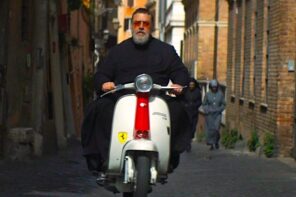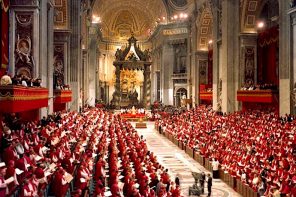As if the whole Louie Giglio inaugural preaching debacle weren’t enough to sour many in on the religiosity of the American political process, conservative evangelical shock preacher Mark Driscoll stirred a hornet’s nest of Christianist hate and Christian outrage with the following tweet during the Presidential Inauguration on Monday:
Praying for our president, who today will place his hand on a Bible he does not believe to take an oath to a God he likely does not know.
—Mark Driscoll (@PastorMark) January 21, 2013
Driscoll has long been an especially obnoxiously “resounding gong or clanging cymbal” (1 Cor. 13:1) in the face of Christian scriptural teachings on radical love and compassion, and it’s easy to dismiss him as a megalomaniac with a new self-pornographizing book to sell every six months. But the string of replies to the tweet, as well as a number of pained blog posts, make clear that Driscoll’s rhetoric is at least as alienating to thoughtful Christians across the ideological spectrum as it is titillating to his followers.
For those Christians often straining to sustain their identification and affiliation with one or another branch of the Christian family, Driscoll comes off like the ranting, half-drunk cousin who shows up at the dinner to which you’ve happened to bring your newest love. He’s embarrassing. He’s humiliating. And your new squeeze has to wonder if that particular kind of hate-filled crazy is somewhere in your gene pool. “How exactly are you related to him?” she asks.
By week’s end, the tweeting pontiff, Benedict XVI, however, was offering a more temperate call to social media participation in his most recent message to the Roman Catholic faithful in anticipation of World Communications Day on May 13. While the Pope highlights the evangelical possibilities of new media for Christians, his message is insistent that such engagement should unfold “in a wise and balanced way” that would seem wholly foreign to Driscoll and his ilk, “conducted respectfully and with concern for privacy, responsibility and truthfulness.”
Benedict’s tone here is admirably restrained, but if it is characteristically thoughtful it is also uncharacteristically charitable toward the idea of open, respectful dialogue with those of different religious and ethical perspectives. While hardly the spitting rant that more or less defines Mark Driscoll, the “gentle voice” of the Holy Father’s for his World Communication Day message is hard to recognize in the tone of his earlier message for World Peace Day on January 1.
Here, after another year of astonishing religion-infused violence and hate across the world, and just a week before the Sandy Hook shootings, the Pope laid responsibility the lack of world peace largely at the feet of those who support abortion rights or marriage equality and went on to a universal authority for his teaching. Benedict’s way more than 140-characters of something other than “wise and balanced” rhetoric in the World Peace Day message is worth our attention:
Those who insufficiently value human life and, in consequence, support among other things the liberalization of abortion, perhaps do not realize that in this way they are proposing the pursuit of a false peace. The flight from responsibility, which degrades human persons, and even more so the killing of a defenseless and innocent being, will never be able to produce happiness or peace. Indeed how could one claim to bring about peace, the integral development of peoples or even the protection of the environment without defending the life of those who are weakest, beginning with the unborn…
There is also a need to acknowledge and promote the natural structure of marriage as the union of a man and a woman in the face of attempts to make it juridically equivalent to radically different types of union; such attempts actually harm and help to destabilize marriage, obscuring its specific nature and its indispensable role in society.
These principles are not truths of faith, nor are they simply a corollary of the right to religious freedom. They are inscribed in human nature itself, accessible to reason and thus common to all humanity. The Church’s efforts to promote them are not therefore confessional in character, but addressed to all people, whatever their religious affiliation.
“In social networks,” says Benedict, “believers show their authenticity” in a variety of forms, including through self-identification as Christians and through the witness of their enactment of Christian values in the ways they communicate with others. I’d add to this list that whatever might be assessed as “authenticity” both digital and local spaces is named so because it appears consistently, from tweet to tweet, blog post to blog post, papal message to papal message. The character of this communication in aggregate comes to define those we encounter in digital spaces, who may not otherwise be “real” to us.
One thing we’ve got to give Driscoll, for all his histrionics—indeed, for the nearly infallibly hate-filled, alienating nature of his social media persona—is that he’s consistent. The pontiff, however, seems consistently contradictory in his new media participation, suggesting dialogue here, shutting it down there.
Those who follow either or both for lessons on how to use new media in the service of faith surely have much to learn. But that learning would hardly be, I expect, what either Driscoll or Benedict would hope.




